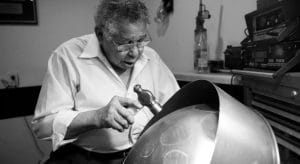Born in Trinidad, Elliot Mannette was captivated by street musicians, pounding out rhythms on anything they could find, such as trash cans, biscuit tins, and paint buckets. Players started hammering the metal from below to raise a hump, and with that they could start getting musical notes. Mannette was fascinated, and started working with metal to see if he could improve the sounds. He was the first with a big innovation: he cut the top off an oil barrel, and pounded the surface into a concave shape, rather than convex — and the modern steel pan, or “steel drum,” was born. “He sank the lid to create a tensed playing surface and fired the metal to improve the acoustic properties,” said the National Endowment for the Arts when it honored Mannette as a Heritage Fellow in 1999. “A variety of steel drums was created, and entire orchestras were formed. These changes helped to propel the instrument into wide popularity. Over the next several decades, Mannette brought an even more sophisticated approach to pan tuning, using a stroboscope to analyze and shape the harmonic blend.”

It’s a complex sound: Manette is probably the first to make a steel drum that had all the notes of the chromatic scale so it could play any melody in any key, with complex harmonics and undertones that makes a pleasing sound that’s far above the street instruments made out of biscuit tins. “He imagined a sound of this instrument that nobody else had imagined for it,” says Shannon Dudley, a University of Washington ethnomusicologist. “He strove to create that sound, and it captivated a lot of people.” In 1967, Mannette was invited to the U.S. to stay, and he eventually settled at West Virginia University, where he taught students how to make and tune pans for nearly 20 years. “He was a natural teacher,” says Director Kim Johnson of the Carnival Institute of Trinidad and Tobago. “His way of making pans became the first globalized way, the first way you’d find all over the country, from people he taught, from bands whose instruments he made, and from people trying to copy him.” Mannette never retired, continuing to build and tune pans in his workshop in Morgantown. He died on August 29 from kidney failure, at 90.
Author’s Note: In about 1981, jazz steel panner Andy Narell gave a demonstration to the music department at Humboldt State University, and then gave a concert that evening at the school. I attended both. It was Narrel’s father, Murray, a social worker in Queens, who invited Mannette to the United States in 1967.
